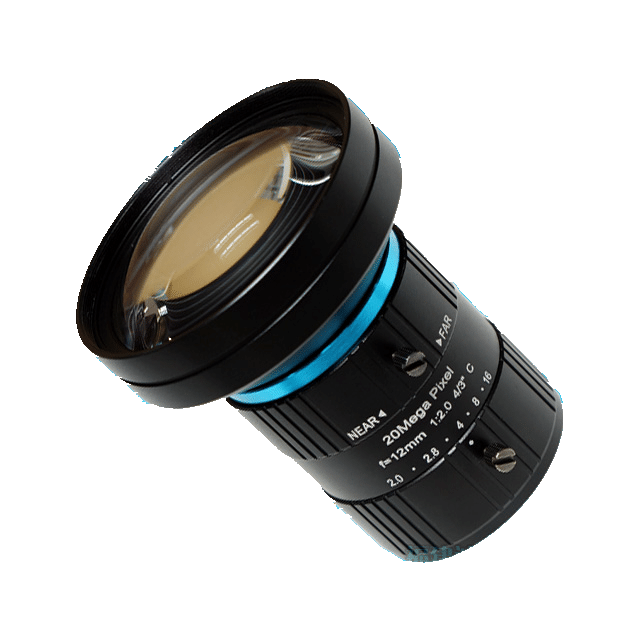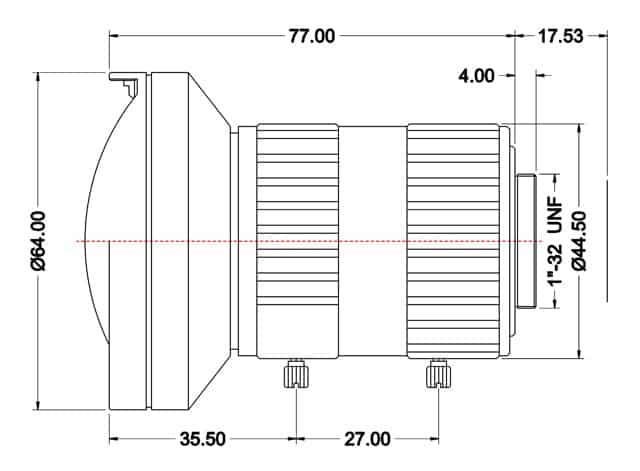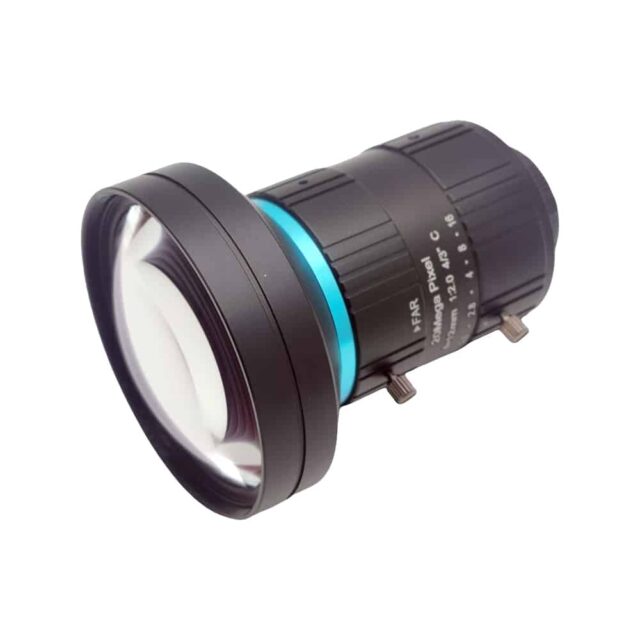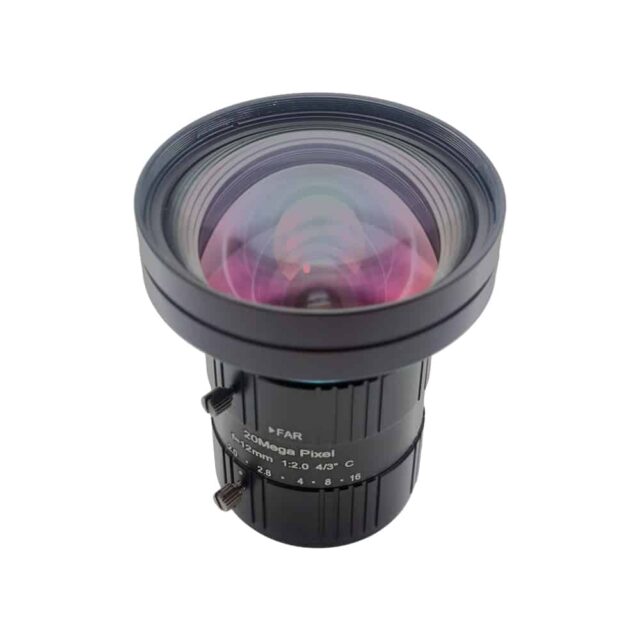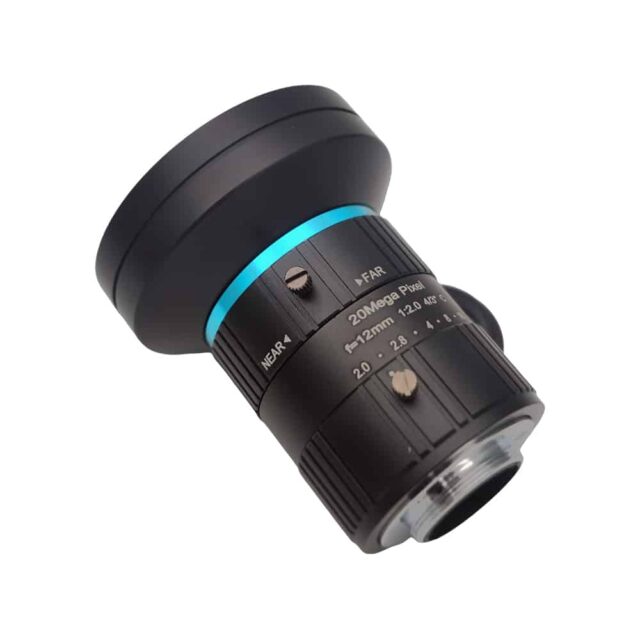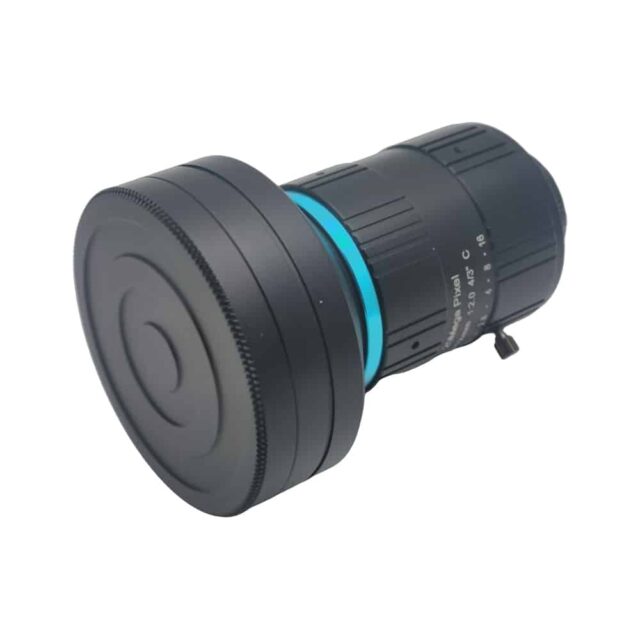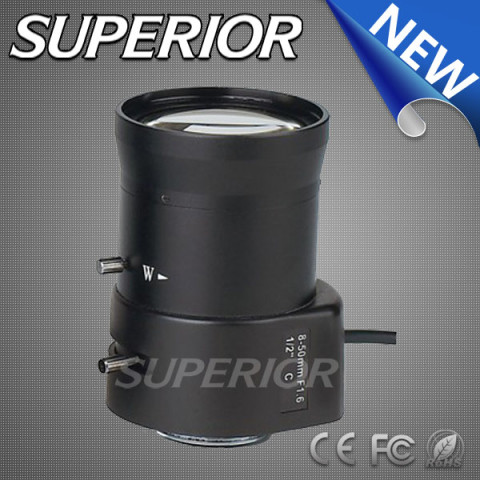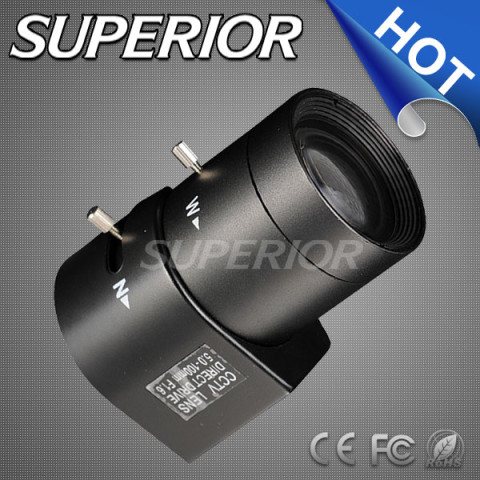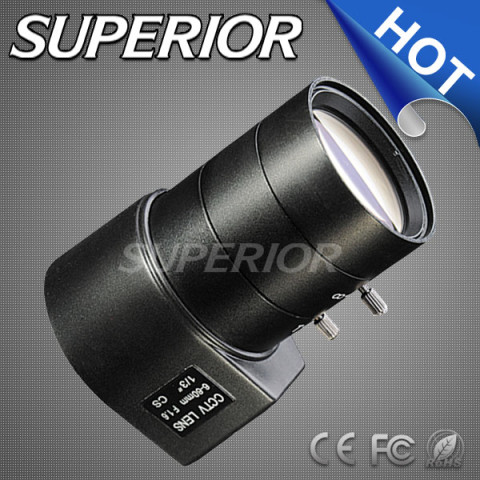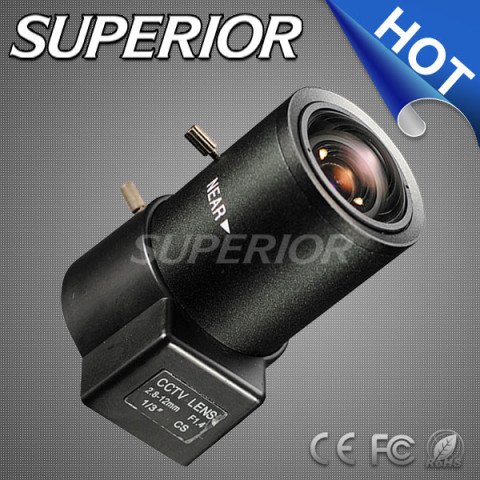Megapixel Lens Manufacturers in China provide 20 Megapixel F/2.0 C-Mount 4/3″ Format 12mm Fixed Focal Length Lens
Product Family Description
- Up to 4/3″ sensor formats, C-Mount Lens
- C-Mount lineup of eight models from f = 5 mm to 100 mm
- Variable focus and iris equipped with locking set screws
- Compact (C), FA Lens for Machine Vision
- Please note this lens does not come with an IR filter
The 4/3″ megapixel lens series provides a large image format of Φ23mm(C-mount) from one of the best Megapixel Lens Manufacturers in China. These high precision aspherical lenses greatly reduce distortion and produces a high definition picture. 4/3″ megapixel lenses maintain megapixel resolution thoughout the entire image even if the iris is fully open. In addition, SUPERIOR® Optics’ wide-band multi-coating effectively reduces glare and refraction.
4/3″ Format 12mm Fixed Focal Length Lens has the following advantages:
Floating Mechanism Design
Superior’s floating mechanism design virtually eliminates optical abberations from close distance to infinity
Extra Low Dispersion
Superior’s wide-band multi-coating effectively reduces glare and refraction
Low Distortion
High precision aspherical lens greatly reduces distortion and produces a high definition picture
Large Image
Large image format Φ23mm (C-mount)
Consistent Megapixel Resolution
Megapixel resolution is maintained throughout the entire image, even if the iris is fully opened
DATA SHEET
| Model No. | SP1220MC20MP43B |
|---|---|
| Focal Length | 12mm |
| Lens Type | Fixed Focal Length |
| Image Size | 4/3″ (Ø23) |
| Iris Range (F-Stop) | F2.0 – 16 |
| Mount | C-Mount |
| Angle of View 4/3″ (Hor. x Ver. x Dia.) | 88.9° x 73.5° x 58.3° |
| Angle of View 1″ (Hor. x Ver. x Dia.) | 67.5° x 56.3° x 43.5° |
| Angle of View 2/3″ (Hor. x Ver. x Dia.) | 48.6° x 39.8° x 30.4° |
| Angle of View ” (Hor. x Ver. x Dia.) | |
| TV Distortion | -1.60% |
| Minimum Object Focus Distance (1″) (Hor. x Ver. x Dia.) | 0.20mm |
| Flange Back | 17.526mm in air |
| Back Focus | 16.5mm in air |
| MTF (Center/Corner) | 20 MegaPixel; Center 100lp/mm; Corner 80lp/mm |
| Iris | Manual (W/Lock) |
| Focus | Manual (W/Lock) |
| Zoom | — |
| Dimension | Φ64.0 x 77.0mm |
| Filter Thread Size | M72 x 0.75P |
| Structure | Aluminium Alloy + 13G (6 Group) |
| Weight | 305g |
| Temperature Range | -10°C ~ +60°C |
| Storage Temperature Range | -20°C ~ +60°C |
EXTERNAL VIEW
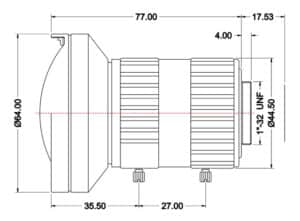
Megapixel Lens Manufacturers
What is the use of a Megapixel Lens?
In the world of digital cameras, photography and videography are thriving, and marketers use them to promote their products. Megapixels refer to the quality of photos. However, why are megapixels important, and how do they create images with high clarity? Well, the top and best Megapixel Lens Manufacturers produce these high-megapixel lenses.
However, if we simply narrate, what are megapixels? It has better image quality.
How Do Megapixels Improve Image Quality?
Megapixels make an image more detailed. The more megapixels there are, the higher the resolution is there. However, the quality of the image depends on many factors. They are lens quality, color resolution, sensor size, dynamic range, and other things that enhance an image quality.
When Does Megapixel Matter?
While the fact that beyond megapixels, other factors that lower the count of megapixels are the situation.
For example, if you capture a photo with a 20 MP file and edit it to a reduced size, will the image be clear? Well, it’s a question mark itself.
However, in the digital world, most images are used and uploaded online, and those don’t exceed 2 MP. However, if you capture an image with 18 MP but it only presents 8 MP, is capturing the photo highly payment-worthy?
How Megapixels Affect Image Cropping?
When you crop an image during your editing process, the resolution is reduced. The smaller the image, the higher the megapixel count, and it offers you flexibility.
It is also applied to the photo that is taken in portrait or landscape format.
For example, if you take a portrait image for social media or a website, the higher the megapixel count will be because this format works best. You can buy the camera from one of the best Megapixel Lens Manufacturers.
Who Requires More Megapixels?
Do you want to click on a clearer image or video? Well, if you do, then you need cameras with megapixels because capturing beautiful images needs the highest quality. You might be a professional photographer or videographer, therefore, you need to use a camera that has megapixels so that you can capture the potential images as a proficient photographer.
The highest-megapixel camera will allow you to take images with maximum details and resolution using the perfect lighting.
In simple words, a photographer needs to buy a camera that can print high-quality, large-format images with great detail. It may provide you with extreme sizes such as 20, 50, 100, and 200 MPs.
So, what are you waiting for? Visit Superior Optics, one of the best Megapixel Lens Manufacturers, and buy the highest-megapixel camera.
C Series Fixed Focal Length Lenses are designed for use in machine vision applications with the working distance and resolution requirements of factory automation and inspection in mind. C Series Fixed Focal Length Lenses feature large maximum apertures, allowing these high performance lenses to be used in even the most restrictive lighting conditions. Each lens has a broadband anti-reflection coating, locking iris and focus adjustment with recessed set screws, and a ruggedized, robust housing for space-restrictive applications. C Series lenses are manufactured to high tolerances, which result in high levels of imaging performance with low lens-to-lens variation. Through combining optical performance, industrial features, and compact package sizes, our C Series Fixed Focal Length Lenses are ideal for use in factory automation and inspection.
The 1″ 10 megapixel C-mount B lens series provides 200lp/mm resolution and low distortion in order to maximize performance for high-end applications. Incorporating SUPERIOR’s broadband coating and floating mechanism design, it greatly reduces chromatic aberration at any distance and maintain a high transmission from visible to NIR.
Floating Mechanism Design
SUPERIOR’s floating mechanism design virtually eliminates optical abberations from close distance to infinity
Excellent Corner Brightness
No fading along edges of the image
Perfect for Large Format 1″ Megapixel Applications
Assists the megapixel camera in producing large, high resolution images
200lp/mm Resolution and Low Distortion
200lp/mm resolution and low distortion will maximize performance for high-end applications
Low Distortion
SUPERIOR’S design solves distortion issues to create an accurate reproduction of the environment
High Transmission from visible to NIR
The Series incorporates wide-band coating and a floating mechanism design to maintain a high transmission from visible to NIR
High Performance and Compact
This high performance lens is optimal for a wide range of applications
Easy Installation
Short minimum object distance and compact design using aspherical lenses (5 models/F-5 ~ 100mm) will allow for easy installation in compact machine vision systems
- Shape recognition
- Food label inspection
- Presence/absense checking
- Security
- 2D bar code reading
Application Notes
- What is SWIR?
- Hyperspectral and Multispectral Imaging?
- UV vs. IR Grade Fused Silica
- Advantages of Using Meniscus Lenses in Infrared Applications?
- The Correct Material for Infrared (IR) Applications?
- Resolution and Contrast Comparison?
- Lens Performance Curves?
- Diffraction Limit?
- Object Space Resolution?
- Wavelength Effects on Performance?
- Comparison of Optical Aberrations?
- How to Choose a Fixed Magnification Lens?
- Basic Lens Selection?
- Lens Spacers and Focal Length Extenders?
- Resolution and MTF Testing?
- An Introduction to Optical Coatings?
- Anti-Reflection (AR) Coatings?
- System Throughput, f/#, and Numerical Aperture?
- Resolution?
- MTF Curves and Lens Performance?
- Relative Illumination, Roll-Off, and Vignetting?
- Distortion?
- Depth of Field and Depth of Focus?
- Aberrations?
- Aberrational Balancing of MTF in Lens Design?
- Lens Mounts?
- Lens Spacers, Shims, and Focal Length Extenders?
- Types of Machine Vision Lenses?
- Advanced Lens Selection?
- Machine Vision Filter Technology?
- What is Imaging?
- Basic Lens Selection?
- From Lens to Sensor: Limitations on Collecting Information?
- Sensors and Lenses?
- Imaging Fundamentals?
- Best Practices for Better Imaging?
- Contrast?
- The Anatomy of a Lens?
- Understanding Focal Length and Field of View?
- The Airy Disk and Diffraction Limit?
- Introduction to Modulation Transfer Function?
- The Modulation Transfer Function (MTF)?
